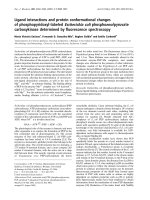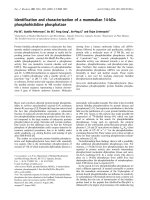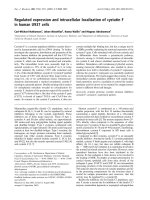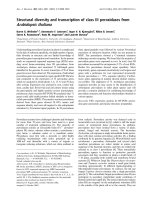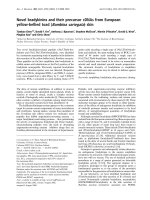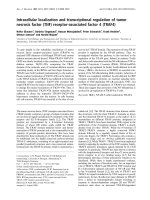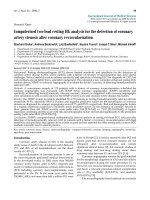Báo cáo y học: "Getting out and about in older adults: the nature of daily trips and their association with objectively assessed physical activity" doc
Bạn đang xem bản rút gọn của tài liệu. Xem và tải ngay bản đầy đủ của tài liệu tại đây (316.66 KB, 28 trang )
This Provisional PDF corresponds to the article as it appeared upon acceptance. Fully formatted
PDF and full text (HTML) versions will be made available soon.
Getting out and about in older adults: the nature of daily trips and their
association with objectively assessed physical activity
International Journal of Behavioral Nutrition and Physical Activity 2011,
8:116 doi:10.1186/1479-5868-8-116
Mark G Davis ()
Kenneth R Fox ()
Melvyn Hillsdon ()
Jo C Coulson ()
Debbie J Sharp ()
Aphrodite Stathi ()
Janice L Thompson ()
ISSN 1479-5868
Article type Research
Submission date 29 March 2011
Acceptance date 21 October 2011
Publication date 21 October 2011
Article URL />This peer-reviewed article was published immediately upon acceptance. It can be downloaded,
printed and distributed freely for any purposes (see copyright notice below).
Articles in IJBNPA are listed in PubMed and archived at PubMed Central.
For information about publishing your research in IJBNPA or any BioMed Central journal, go to
/>For information about other BioMed Central publications go to
/>International Journal of
Behavioral Nutrition and
Physical Activity
© 2011 Davis et al. ; licensee BioMed Central Ltd.
This is an open access article distributed under the terms of the Creative Commons Attribution License ( />which permits unrestricted use, distribution, and reproduction in any medium, provided the original work is properly cited.
- 1 -
Getting out and about in older adults: the nature of
daily trips and their association with objectively
assessed physical activity
Mark G. Davis
§1
, Kenneth R. Fox
1
, Melvyn Hillsdon
2
, Jo C. Coulson
1
, Debbie J
Sharp
3
, Aphroditi Stathi
4
and Janice L. Thompson
1
.
1
Centre for Exercise, Nutrition and Health Sciences, School for Policy Studies
University of Bristol, Bristol, UK
2
School of Sport and Health, University of Exeter, Exeter, UK
3
Academic Unit of Primary Health Care, School of Social and Community Medicine,
University of Bristol, Bristol, UK
4
School for Health, University of Bath, UK
§
Corresponding author
Email addresses:
MGD:
KRF:
MH:
JC:
DJS:
AS:
JLT:
- 2 -
Abstract
Background
A key public health objective is increasing health-enhancing physical activity (PA)
for older adults (OAs). Daily trip frequency is independently associated with
objectively assessed PA volumes (OAs). Little is known about correlates and these
trips’ transport mode, and how these elements relate to PA. Purpose: to describe the
frequency, purpose, and travel mode of daily trips in OAs, and their association with
participant characteristics and objectively-assessed PA.
Methods
Participants (n=214, aged 78.1 SD 5.7 years), completed a seven-day trips log
recording daily-trip frequency, purpose and transport mode. Concurrently
participants wore an accelerometer which provided mean daily steps (steps·d
-1
), and
minutes of moderate to vigorous PA (MVPA·d
-1
). Participants’ physical function
(PF) was estimated and demographic, height and weight data obtained.
Results
Trip frequency was associated with gender, age, physical function, walking-aid use,
educational attainment, number of amenities within walking distance and cars in the
household. Participants reported 9.6 (SD 4.2) trips per week (trips·wk
-1
). Most trips
(61%) were by car (driver 44%, passenger 17%), 30% walking or cycling (active) and
9% public transport/other. Driving trips·wk
-1
were more common in participants who
were males (5.3 SD 3.6), well-educated (5.0 SD 4.3), high functioning (5.1 SD 4.6),
younger (5.6 SD 4.9), affluent area residents (5.1 SD 4.2) and accessing > one car (7.2
SD 4.7). Active trips·wk
-1
were more frequent in participants who were males (3.4 SD
3.6), normal weight (3.2 SD 3.4), not requiring walking aids (3.5 SD 3.3), well-
educated (3.7 SD 0.7), from less deprived neighbourhoods (3.9 SD 3.9) and with ≥ 8
amenities nearby (4.4 SD 3.8).
- 3 -
Public transport, and active trip frequency, were significantly associated with steps·d
-1
(p<0.001), even after adjustment for other trip modes and potential confounders.
Public transport, active, or car driving trips were independently associated with
minutes MVPA·d
-1
(p<0.01).
Conclusions
Daily trips are associated with objectively-measured PA as indicated by daily MVPA
and steps. Public transport and active trips are associated with greater PA than those
by car, especially as a car passenger. Strategies encouraging increased trips,
particularly active or public transport trips, in OAs can potentially increase their PA
and benefit public health.
Background
In the UK, the number of adults aged over 65 years increased between 1983 and 2008
by 1.5m and those over 85 years increased from 600,000 to 1.3 million [1]. Current
projections suggest that those over 85 years will double in number by 2033. It is,
therefore, increasingly important to find ways of facilitating the maintenance of
physical function, health and independence and quality of life of older individuals.
This in turn will help reduce the substantial financial and personal burden of health
and social care costs incurred by the older adult population. Physically active older
adults have lower risk of disease including dementia, higher levels of physical and
cognitive function, psychosocial well-being and independence than inactive older
adults [2]. However, less than 10% of those over 75 years meet the minimum amounts
of activity recommended for health (30 minutes of at least moderate physical activity
on five or more days per week) [3].
- 4 -
Both recreational physical activity (e.g., walking, gardening, bowls, exercise classes
and swimming) and activity undertaken while performing daily tasks such as
shopping and visiting friends (e.g., walking and cycling) are recommended for
increasing overall levels of physical activity in older adults [4]. However,
participation rates in recreational physical activity for those over 70 years is limited
(walking 27.9%, Swimming, 8.4%, keep fit and yoga 6.4%, bowls 4.8%, golf, 4.4%
cycling 3.2%) [5]. National Travel Survey data [6] provide some indication as to the
frequency and mode of transport for trips made from home. In adults over 70 years,
38% of all trips made were as a driver of a car, 23% as a passenger, 21% on foot, 12%
by bus and just 1% by bicycle. The purposes of these trips are diverse with shopping
accounting for 39%, sport and entertainment for 8%, and going for a walk (for leisure)
5% of all trips.
.
Although much research has been conducted on structured programmes of physical
activity [7] much less is known about daily patterns of movement and their
association with overall levels of physical activity [8]. Recent evidence from Japan
indicates that getting out and about in the local neighbourhood is beneficial for
maintaining physical function in the frail elderly [9].
Our own research with Project OPAL (Older People and Active Living) -
- has also investigated these factors in older
adults. Project OPAL was designed to provide comprehensive assessment of patterns
and levels of activity, functionality, well being and perceptions of the environment.
- 5 -
We have previously reported the associations between trips per week and of
accelerometer assessed PA [10, 11] as well as the association between
neighbourhood deprivation and physical activity in 240 UK adults aged 70 and over .
We found that trip frequency was one of a number of correlates of the daily steps
(steps·d
-1
) and moderate to vigorous physical activity (MVPA) compared to those
who made least (<7) trips per week (p<.001) [10] and warranted further exploration.
This study aims to describe the frequency, purpose, and travel mode of daily trips in
adults over 70 years (y), and their association with participant characteristics and
objectively assessed PA.
Understanding the nature of this relationship is important because it is currently
unclear whether policy to increase activity in older adults should focus on the
provision of facility-based structured exercise programmes or facilitation of free-
living activities based in the local community.
Methods
Sampling and recruitment
A diverse sample of participants over 70 years were recruited to Project OPAL by
written invitation via the patient lists of general medical practices distributed within
the boundaries of a large city in the UK (Bristol). Practices were stratified by
amenity access (the number of patients within each practice from areas with either
low ≤0.38k, or high ≥1.50k, proximity to the nearest shop as defined by the English
Index of Multiple Deprivation [IMD]). IMD combines 38 economic, social and
housing indicators into a single deprivation score for each locality, with a high score
denoting a high level of deprivation [12]. A three by two sampling matrix based on
tertiles of IMD and the top and bottom 10% of amenity access was used to select 12
- 6 -
practices distributed across Bristol with a broad range of social economic groups and
environmental settings.
Participants were randomly selected from patient lists and minimal exclusion criteria
(namely: 1) recent bereavement, 2) terminal illness, 3) debilitating mental illness, 4)
inability to complete a questionnaire, 5) any other illness preventing participation)
were employed to maximise the diversity of the sample. Invitations to participate, an
information pamphlet, and consent form were mailed to those patients who were not
excluded by the practice administrator. Return of the consent form to the research
team initiated inclusion in the project. The study was approved by the Bristol
Southmead Research Ethics Committee (Reference 06/Q2002/127). Data was
collected between April 2007 and December 2008
Measures
Physical activity was assessed through accelerometry (Actigraph GT1Ms).
Participants were supplied with an Actigraph and briefed on its use at the first (visit
#1) of two home visits. Participants were asked to wear the Actigraph for seven days
during waking hours, removing it only for bathing, water-based activities or when
suffering discomfort. The instrument was worn in a custom Velcro™ pouch attached
to the participant’s own belt or a supplied elastic belt. Actigraphs were programmed
to record activity in 10-second epochs, producing both count and pedometer data.
Also at visit #1 participants were supplied with and briefed on how to complete the
daily trips log. The daily trips log was used to record details of the days and times
when the Actigraph was worn and any trips made away from the home. For each trip,
participants recorded the purpose (shopping, personal business [e.g., banking or
posting letters], visiting friends or family, sport or exercise, day trip or excursion,
- 7 -
going for a walk or walking the dog, escorting a friend or relative, work or volunteer
activity, entertainment or going out to eat or drink, or “other”) and in addition, the
main mode of transport (walking, cycling, driving, car passenger, bus, train, or
“other”) for each trip was recorded.
Also during visit #1 height and weight were measured using stadiometer and portable
scales respectively, and physical function was assessed using the Short Physical
Performance Battery (SPPB) [13]. Demographic data were collected through an
interviewer-administered questionnaire. Participants were asked to report their highest
level of education completed (options were: primary school, middle school, some
secondary school, completed secondary school, some college or vocational training,
completed college or university, completed graduate degree or higher) , these
categories were late collapsed to three groups: primary/middle (includes those did
some, but did not complete secondary school), secondary, and tertiary (some college
or vocational training and above). Participants were asked how many drivable motor
vehicles there were at the household and whether they regularly used a Zimmer frame,
walking stick or other walking or mobility aid. The participant’s residential postcode
was used to derive the relevant Index of Multiple Deprivation (IMD) score. Further,
participants were asked to indicate from a check list which amenities were perceived
to be within a five-minute walk from their home. At visit #2 (usually seven to nine
days after visit #1) the accelerometer and log were retrieved and responses to any
remaining unanswered questions from the questionnaire recorded.
Data reduction and analyses
Logs were inspected and entries for specified “other” trip purposes tabulated. Any
specified options in the “other” category that were found to map onto existing options
- 8 -
were re-coded to that option. Frequently occurring “other” options that did not map
onto existing options were reclassified into new discrete options (“health” e.g., visit to
hospital or GP, “religion” e.g., going to church, “gardening” e.g., tending an allotment
or other remote garden, “hobby” e.g., playing musical instrument or card games away
from home). Reclassification was performed by a researcher and decisions checked
and confirmed by another researcher who was familiar with the data. The date of data
collection was used to identify the current season and allow determination of seasonal
influences on trips.
Actigraph data were downloaded using Actilife Lifestyle Monitoring System v. 3.1.3
software. Files failing to meet the inclusion criteria of ten hours of monitoring on at
least five days, were excluded from analysis. Trip logs with fewer than five days of
entries were also excluded. Both log data (number of trips) and accelerometry data
were summed and then divided by the number of days for which data was collected
(e.g., steps per day). For ease of interpretation a weekly equivalent trip frequency
score was derived by multiplying the daily score by seven and this was used in
analyses. Actigraph data were then reduced using MAH/UFFE Analyser v. 1.9.0.3
[14] set to ignore runs of 100 minutes of zeros. Prior investigation [15] has indicated
that long periods of zero counts are not uncommon in this population and that setting
this parameter any lower may risk distorting the data provided by the least active
participants. Daily steps (steps·d
-1
) and minutes of at least moderate physical activity
(≥1952 counts per minute, ≥ 3METs) (MVPA) were derived via batch processing.
Data were first checked for normality. Non-normally distributed data were
transformed using the formula log [x+1]. Independent t-tests or one way analysis of
- 9 -
variance (ANOVA) were used to determine differences between groups. Bivariate
correlations were used to establish the strength of relationships between weekly trips
and physical activity. The unadjusted association between respondent characteristics
and trips per week separately for males and females was examined using one-way
ANOVA. Each independent variable with a P value < 0.05 in the ANOVA was
treated as a covariate in a series of ordinary least squares regression models to
examine the association between the frequency of weekly trips by mode of travel,
steps per day and MVPA. We have previously shown that gender is not associated
with physical activity in this population. Therefore, for this reason and to retain power
we did not run gender specific models.
Results
Participants
Of the 1172 older adults invited to participate, 662 were females (mean age 78.6 ± 8.6
years [y]) and 510 were males (mean age 77.5 ± 5.6y). Responses were received from
725 individuals, 481 declined to participate, 244 gave informed consent to participate
and 240 completed the study. The overall recruitment rate from those invited to take
part was 20.8%. Although recruitment of members of this age group for physical
activity studies is challenging [16] a representative sample for gender, age, and BMI
was achieved. The age and gender of the sample differed minimally from the patient
lists from which they were selected. The differences in proportions between pooled
practice lists and recruits in each age group were: males 70-74y 6.5%, 75-84y
+4.4%, 85-89y +0.9%, ≥ 90y +1.2%; females 70-74y -4.4%, 75-84y -7.0% , 85-89y
+7.8%, ≥90y +3.6%. Participants’ IMDs were fairly representative of the IMD
distribution in England [17] (distribution within national tertiles: low, 30.4%, mid,
- 10 -
38.8, high 30.8%). From the 240 study participants, 16 participants failed to provide
trip logs with at least five days of data, three failed to meet the inclusion criteria for
accelerometer data (≥5 days of data), and seven failed to provide both valid
accelerometer and valid log data . There were 214 participants who provided both
accelerometry and log data that met the inclusion criteria.
Trip frequency
The 214 participants recorded a total of 2007 trips over the seven days of recording.
Only two participants did not perform any trips. Mean trips per week were 9.6 (SD
4.2), median trips per week were 9.0, and were normally distributed (Skewness
0.612, Kurtosis 0.215). The distribution among trip frequency categories was: low
(<6.0 trips·wk
-1
) n=44, low-mid (6.0-8.9 trips·wk
-1
) n=58, mid-high (9.0-12.9
trips·wk
-1
) n=56, high (≥13 trips·wk
-1
) n=56. Trip frequencies for selected participant
characteristics are displayed in the last column of Table 1. Females recorded 1.8
fewer trips·wk
-1
than males (p=0.008). Significantly fewer trips·wk
-1
were recorded
by older participants, those low in physical function, using walking or mobility aids,
educated to a lower level, living in more deprived areas, reporting fewer amenities
within a five-minute walk of their home and living in households with just one car or
no car at all. There were no significant trip frequency effects for BMI, living alone or
season (F[3]=.450, p=.717).
Purposes of trips
Trip purposes (see Figure 1) were shopping (33.2%), visiting friends or family
(12.7%), entertainment (10.2%), personal business (10.2%), going for a walk (6.0%),
work or volunteer activities (5.7%), escorting a friend or relative (5.3%), sport or
exercise (5.2%), visiting a GP or other health-related visit (3.1%), going on a day trip
- 11 -
(2.5%), hobby (1.9%), religion or church attendance (1.8%), allotment or gardening
(1.7%), other (0.4%) (N.B. multiple purposes for a single trip were allowed the
proportions presented are for all purposes [n=2519] as opposed to trips). The mean
trip frequency per week by trip purposes is presented in Figure 2. The most frequent
purpose for a trip was for shopping (3.9 SD 2.7 trips·wk
-1
). Other trip purposes that
occurred at least once per week were visiting others (1.5 SD 1.5 trips·wk
-1
),
entertainment, e.g., going out for a drink or a meal (1.2 SD 1.5 trips·wk
-1
) and
personal business (1.2 SD 1.4 trips·wk
-1
). Males reported more shopping trips per
week (5.0 SD 3.1 trips·wk
-1
) than females (3.5 SD 1.8, p<.001) with the difference
largely accounted for by the higher overall trip frequency recorded by males.
Modes of transport used for trips
Trips (including those for the purpose of just going for a walk) were made by car
(driving 42.7%, passenger 16.8 %), through physical activity (walking 31.2%, cycling
1.1%) by public transport or other means (bus 7.2%, train 0.4%, other 0.7%). The
proportion of trips made by these different modes of transport is shown by trip
purpose in Figure 2. The proportion of active trips was greater than car-based trips
for walking, gardening and religion but these accounted for just 6.0% of all trip
purposes. For most purposes of trip, and for the most frequently reported purposes of
trip (shopping), the car was the most frequently used mode of travel.
Males made twice as many trips·wk
-1
as a car driver than females, whereas females
made twice as many trips·wk
-1
as a passenger or by public transport (see Table 1).
Trips·wk
-1
as a car driver declined with age and physical function. Those 70.0-74.9y
and high in physical function made five times as many trips·wk
-1
as a car driver as
- 12 -
those ≥ 85y or low in physical function respectively. Those who did not use a walking
or mobility aid made twice as many trips as a car driver than those who used such
aids. These differences in trip frequency for car driving were not compensated for by
other travel modes.
Association of trips with physical activity
There was a consistent moderate correlation for the frequency of trips with both daily
steps (range R .367 - .505, p<.001) and MVPA (range R .361 - .472, p<.001) across
the different days of the week (see Table 2). There was also a correspondingly lower
level of activity on weekend days when there were fewer trips made. Table 3 shows
the association between trips·wk
-1
by mode of travel, steps ·d
-1
and MVPA·d
-1
. Age and
sex adjusted trips per week accounted for 46% of the variance in steps ·d
-1
(adjusted
R
2
0.46) and 42% of the variance in MVPA·d
-1
(adjusted R
2
0.42). Each weekly trip
made by public transport is associated with an additional 478 steps ·d
-1
(SE 93.8,
p<0.001). Corresponding values for car trips as a driver and walking/cycling trips are
166 steps ·d
-1
(SE 36.5, p<0.001) and 352 steps ·d
-1
(SE 40.3, p<0.001). Trips as a car
passenger were not associated with steps ·d
-1
. Following mutual adjustment for other
trip types , age, sex, physical function, use of a walking aid, education and car
ownership, the association between trips taken by public transport and walking or
cycling were attenuated somewhat but remained significant. Car driver trips were no
longer associated with steps ·d
-1
. Trips by public transport, car driving and
walking/cycling were also associated with MVPA·d
-1
(p<0.01) even after adjustment.
- 13 -
Discussion
This study aimed to assess the relationship between frequency, purposes and transport
mode of daily trips, with participant characteristics and with accelerometry-assessed
daily physical activity. We have combined objective data from a diverse sample of
older adults on physical activity, physical function and self report data on trips made
out of the home (including frequency, purposes and modes of travel for trips). We
believe this study is unique in this respect. The associations we have found for trips
and their modes and purposes with physical activity and with participant
characteristics help improve our understanding of the importance of “getting out and
about” behaviour for older adults.
Levels of PA and MVPA in older adults are low [3], and were so in this sample [10],
so it is important to identify lifestyle and demographic factors that contribute to both
PA and MVPA. We found that the frequency of making trips away from the home is
associated both with increased walking and time spent in MVPA on a daily and
weekly basis. We also found that weekend days produced least trips occurred and
this coincided with lowest daily levels of PA. This reconfirms the important
contribution that daily trips make to PA in older adults.
Active trips, and those by public transport make bigger contributions to PA than by
car. Even after adjustment for potential confounders a trip outdoors each day by foot
or bicycle is associated with an estimated extra 20 minutes of daily walking
(assuming 100 steps per minute [18]) and 13 minutes of MVPA. Equivalent values for
a daily trip by public transport are 29 minutes of daily walking and 20 minutes of
MVPA. These results confirm previous research [19] showing use of public transport
was associated with higher physical activity when compared to private motorised
- 14 -
transport. Our findings also suggest that not only does public transport offer
increased opportunities for getting out and about but may provide additional
important contributions to physical activity over and above that generated by getting
out of the house. Not only was there an association for public transport with the
volume of walking, but also there was an association with the intensity of activity
(MVPA). This is an important effect in a population where volumes of MVPA are
low and suggests that the walking component of trips made by public transport may
be made at a brisk pace.
Although active travel and use of public transport are associated with higher levels of
activity, there is a very strong reliance by older people on use of the car for journeys
away from home. Males tended to drive and women were passengers. This is
supportive of National Transport Survey data [6] providing similar findings (driving
trips: males 57%, females 21%, passenger trips males 9%). Being a frequent driver is
associated with higher activity but being a passenger is not. Possible explanations are
that car passengers have lower function, and are more likely to report using a walking
aid than car drivers. Alternatively it may be that passengers are not actively involved
in the trip purpose (i.e., they stay in the car).
While available, the car probably assists in helping older adults make more trips, with
lower life expectancies in males [20], this poses a potential challenge for widowers
previously reliant on their spouse as the main driver. Therefore older women are
more dependent on trips that can be made on foot or by public transport which in turn
requires personally important destinations that can be reached by these modes of
travel.
- 15 -
While there was a wide variety of purposes of trips for older adults, shopping
accounted for a third of all trips, similar to that found in the NTS that reported 39% of
trips were for shopping [6]. The NTS showed that the proportion of trips for
commuting and business decline steeply after age 59y as the proportion of trips for
shopping, personal business and visiting friends and family increase. So it appears
that shopping is the main reason for making a trip once people retire from work.
Relatively few trips are made for leisure and fitness purposes, including going for a
walk for pleasure only or to take part in sport or exercise.
Access to shops and other services would therefore seem important for encouraging
trips out. We found that having several amenities within five minutes’ walk of home
was associated with more frequent trips across all transport modes combined.
However, the effect was particularly prominent for trips on foot or by bike. If we are
to promote increased levels of walking and public transport trips it follows that these
type of destinations need to be accessible via these modes of travel. The alternative is
further reliance on the car and the problem it brings in terms of congestion, pollution
and its loss when driving is no longer possible.
Limitations
Our data are cross-sectional and as a result we cannot determine the direction of the
relationship between frequency, purpose and mode of trips with physical activity. It is
possible that physically active people take more trips rather than trips leading to more
physical activity. Therefore longitudinal data are needed to confirm or refute our
- 16 -
findings. The trip data is by daily recall and there may be some misclassification of
trip frequency. However, as long as any misclassification was not differential with
regards to physical activity then the effect is likely to attenuate rather than exaggerate
any associations between trip frequency and physical activity.
We aggregated trip data to weekly totals and averaged the weekly volume of physical
activity to daily totals and show a general association between trip frequency and
physical activity. This may reduce the heterogeneity of the data and weaken the
argument about the temporal specificity of the relationship. A multilevel analysis with
days clustered within individuals may have added precision to the association by
directly linking trips on a given day to physical activity on the same day. The study
was not designed to accommodate a multilevel analysis but this would be of value in
future studies. Nevertheless we provide a close examination of associations between
trips and PA on separate days of the week and have found consistent relationships
across the week suggesting that trips are associated with PA on the same day rather
than trips simply being indicative of a more active lifestyle.
There is debate over whether MVPA cut points used for younger adults are
appropriate for older adults and those with impaired mobility [21]. Until it is practical
to compute relative measures of intensity this issue is recognised as a limitation of
accelerometer-based studies of older adults.
- 17 -
Conclusions
Trips away from the home are associated with objectively measured physical activity,
both as volume of MVPA, and steps per day. Shopping is an important activity, and
combined with trips for personal business accounted for nearly half of all trips out of
the house. Increasing opportunities and convenience for shopping and undertaking
personal business for older adults should support more physical activity. However,
the mode of transport used for trips away from the home is also important. Trips
made by public transport, or walking provide more activity than those made by car,
and especially as a passenger in a car. Strategies to encourage increased trips in older
adults, particularly those by active means or via public transport have the potential to
increase physical activity in older adults and benefit public health.
Therefore, local shops and services that are within walking distance or accessible
through public transport should be regarded as an important local resource for
enhancing physical activity in older adults.
Abbreviations
ANOVA, analysis of variance. BMI, body mass index. GP, general practitioner.
IMD, Index of Multiple Deprivation. Ln, log transformed. METs, metabolic units,
MVPA·d
-1
, moderate to vigorous physical activity per day. NTS, National Travel
Survey. OPAL, Older People and Active Living. PA,physical activity. PF, physical
function. SD, standard deviation. SE, standard error. SPPB, Short Physical
Performance Battery. Steps·d
-1
, steps per day. Trips·wk
-1
, trips per week. Y, years.
- 18 -
Competing interests
The authors declare that they have no competing interests.
Authors' contributions
MD conceived and designed the study of trips and association with objectively
measured physical activity. KF was primary investigator for Project OPAL, from
which the data was derived. KF, MH and JT contributed the design of the study,
analysis of data and interpretation of results. JC was involved in data acquisition. DS
contributed to design of recruitment strategies. KF, MH, JT, DS and AS were co-
applicants for Project OPAL and contributed to its conception and design. All authors
read and approved the final manuscript.
Acknowledgements
The OPAL project was funded by the Phase 1 National Prevention Research Initiative
) that is supported by the British Heart Foundation, Cancer
Research UK, Department of Health, Diabetes UK, Economic and Social Research
Council, Medical Research Council, Research and Development Office for the
Northern Ireland Health and Social Services, Chief Scientist Office, Scottish
Executive Health Department, Welsh Assembly Government, and World Cancer
Research Fund. We would like to thank all the participants for their time and
generosity, Bristol Primary Care Trust and the South West General Practitioners Trust
for their additional financial support. Finally, we would like to thank Tanya Trayers,
Georgina Bentley and Carina Thorstensson for their sensitive and skilful assistance.
- 19 -
References
1. Office for National Statistics: Population Trends. vol. 138. London: Office
for National Statistics; 2009.
2. Department of Health Physical Activity Health Improvement and Prevention:
At Least Five a Week: Evidence on the Impact of Physical Activity and its
Relationship to Health. A report from the Chief Medical Officer. pp. 1-9.
London, UK.: Department of Health Physical Activity Health Improvement
and Prevention; 2004:1-9.
3. Craig R, Mindell J, Hirani V: Health Survey for England 2008: Physical
activity and fitness. vol. 1. London: NHS Information Centre for Health and
Social Care; 2009.
4. DiPietro L: Physical activity in aging: Changes in patterns and their
relationship to health and Function. J Gerontol A Biol Sci Med Sci 2001,
56:13-22.
5. Fox K, Richards L: Sport and Leisure: Results from the sport and leisure
module of the 2002 General Household Survey. London: The Office for
National Statistics; 2004.
6. Transport Statistics:Department for Transport: Transport Statistics Bulletin -
National Travel Survey: 2008. London: National Statistics; 2009.
7. Chin A Paw MJM, Van Uffelen JGZ, Riphagen I, Van Mechelen W: The
functional effects of physical exercise training in frail older people: A
systematic review. Sports Med 2008, 38 (9):781-793.
8. Merom D, Van Der Ploeg HP, Corpuz G, Bauman AE: Public health
perspectives on household travel surveys: Active travel between 1997 and
2007. Am J Prev Med 2010, 39 (2):113-121.
9. Shimada H, Ishizaki T, Kato M, Morimoto A, Tamate A, Uchiyama Y,
Yasumura S: How often and how far do frail elderly people need to go
outdoors to maintain functional capacity? Arch Gerontol Geriatr 2010,
50:140-146.
10. Davis MG, Fox KR, Hillsdon M, Sharp DJ, Coulson JC, Thompson JL:
Objectively measured physical activity in a diverse sample of older urban
UK adults. Med Sci Sports Exerc 2011, 43:647-654.
11. Fox KR, Hillsdon M, Sharp D, Cooper AR, Coulson JC, Davis M, Harris R,
McKenna J, Narici M, Stathi A, Thompson JL: Neighbourhood deprivation
and physical activity in UK older adults. Health & Place 2011, 17:633-640.
12. Social Disadvantage Research Centre: The English Indices of Deprivation
2004. pp. 14-42. Oxford, UK.: University of Oxford; 2004:14-42.
13. Guralnik JM, Simonsick EM, Ferrucci L, Glynn RJ, Berkman LF, Blazer DG,
Scherr PA, Wallace RB: A short physical performance battery assessing
lower extremity function: association with self-reported disability and
prediction of mortality and nursing home admission. J Gerontol 1994,
49:M85-94.
14. MRC Epidemiology Unit: MAH/UFFE Analyzer Version 1.9.0.3.
Cambridge: MRC Epidemiology Unit,; 2005.
15. Davis MG, Fox KR: Physical activity patterns assessed by accelerometry
in older people. Eur J Appl Physiol 2007, 100:581-589.
16. Hildebrand M, Neufeld P: Recruiting older adults into a physical activity
promotion program: Active living every day offered in a naturally
occurring retirement community. Gerontologist 2009, 49:702-710.
- 20 -
17. Indices of Deprivation 2007
[
/>uk/communities/neighbourhoodrenewal/deprivation/deprivation07/]
18. Marshall SJ, Levy SS, Tudor-Locke CE, Kolkhorst FW, Wooten KM, Ji M,
Macera CA, Ainsworth BE: Translating physical activity recommendations
into a pedometer-based step goal: 3000 steps in 30 minutes. Am J Prev Med
2009, 36:410-415.
19. Villanueva K, Giles-Corti B, McCormack G: Achieving 10,000 steps: A
comparison of public transport users and drivers in a University setting.
Prev Med 2008, 47 (3):338-341.
20. Office for National Statistics: Life expecancy at birth and at age 65 by local
areas in the United Kingdom, 2006-08. London: National Statistics; 2009.
21. Copeland JL, Esliger DW: Accelerometer assessment of physical activity in
active, healthy older adults. Journal of Aging and Physical Activity 2009,
17:17-30.
Figures
Figure 1 - Mean trips per week for different trip purposes
Mean trips per week for all 214 participants regardless of whether they did any trips
for these purposes. Multiple purposes allowed for a single trip.
Shopping: shopping but not post office or banking activities that would be covered by
personal business. Visit: visiting friends and family. Entertainment: activities such
outings for a meal, drink, cinema and any other entertainment activities including
watching sport. Personal: personal business activities such as post office business,
banking dry cleaning. Walk: going for a walk or walking the dog. Work: doing paid
work or volunteer activities. Escort: taking or accompanying a friend or relative (e.g.,
grandchild) to another venue (e.g., school). Sport: active involvement in a sporting
activity or exercise session. Health: visiting a health practitioner (e.g., GP, dentist),
hospital , clinic, or pharmacy. Day trip: going on a day trip, excursion or short break.
- 21 -
Hobby: attending arts or crafts activity groups or games groups (e.g., playing cards).
Religion: attending a religious service or meeting. Gardening: doing gardening or
allotment work away from the confines of the participant’s home (not attending to
own garden). Other: unspecified activities or activities not covered by the previous
categories.
Figure 2 - Transport modal split for different trip purposes
Public/other: trips made by bus, train or unspecified other transport. Passenger (car):
trips made as passenger in a car. Drive (car): trips made as a driver of a car. Active:
trips made on foot or by bicycle. See figure 1 for key to purposes.
- 22 -
Tables
Table 1 - Mean trips per week made by different transport modes for selected participant characteristics
Trips∙wk
-1
(mean ± SD)
a
Transport mode
n Drive (car) Passenger (car) Active Public/other Total
Gender
Female 105 2.6 ± 2.7 2.2 ± 2.5 2.6 ± 2.7 1.0 ± 1.8 8.7 ± 3.9
Male 109 5.3 ± 3.6 1.0 ± 1.5 3.4 ± 3.6 0.5 ± 1.2 10.5 ± 5.6
T-test t=-4.7, p<.001 t= 4.4, p<.001 t= -1.8, p=.08 t= 2.6, p=.01 t= 2.7, p=.008
Age group
70-74.9y 76 5.6 ± 4.9 1.5 ± 2.2 3.6 ± 3.6 0.6 ± 1.3 11.5 ± 5.4
75-79.9y 58 4.6 ± 4.2 1.5 ± 1.9 2.9 ± 3.1 0.6 ± 1.1 9.9 ± 4.7
80-84.9y 54 2.4 ± 3.3 1.6 ± 2.0 2.6 ± 2.6 1.2 ± 2.1 8.2 ± 3.5
≥85y 26 1.1 ± 1.9 2.0 ± 2.4 2.5 ± 3.2 0.6 ± 1.6 6.4 ± 4.2
ANOVA F=11.4, p<.001 F=0.4, p=.725 F=1.3, p=.280 F=2.4, p=.068 F=9.9, p<.001
BMI category
Normal (<25 kg∙m
2
)
b
70 3.6 ± 4.6 1.4 ± 2.2 3.2 ± 3.4 1.4 ± 2.1 9.9 ± 4.6
Overweight (25.0-29.9
kg∙m
2
)
86 4.2 ± 3.7 1.4 ± 1.8 3.5 ± 3.4 0.3 ± 0.8 9.6 ± 5.2
Obese (≥ 30 kg∙m
2
) 58 4.1 ± 4.9 2.0 ± 2.4 2.0 ± 2.4 0.6 ± 1.3 9.2 ± 4.8
ANOVA F=0.4, p=.701 F=2.1, p=.120 F=3.9, p=.022 F=10.4, p<.001 F=0.4, p=.699
Physical Function (SPPB
score category)
Low (≤6) 28 1.0 ± 1.4 2.1 ± 2.4 1.7 ± 2.8 0.5 ± 1.4 5.4 ± 3.6
Mid (7-9) 50 2.5 ± 3.2 1.6 ± 1.8 2.1 ± 2.3 0.9 ± 1.7 7.6 ± 3.8
High (≥10) 136 5.1 ± 4.6 1.5 ± 2.1 3.6 ± 3.4 0.8 ± 1.5 11.2 ± 4.9
ANOVA F=15.6, p<.001 F=0.9, p=.401 F=7.1, p=.001 F=0.5, p=.619 F=26.9, p<.001
Walking and mobility aid
use
None 153 4.6 ± 4.4 1.5 ±2.1 3.5 ± 3.3 0.7 ± 1.5 10.6 ± 4.7
- 23 -
Walking aid 55 2.4 ± 3.7 1.8 ± 2.0 2.6 ± 2.6 0.9 ± 1.8 7.5 ± 4.7
Mobility aid 6 2.2 ± 3.4 2.5 ± 2.3 0.0 0.3 ± 0.5 5.2 ± 2.1
ANOVA F=6.1, p=.003 F=1.0, p=.368 F=7.0, p=.001 F=0.4, p=.664 F=11.8, p<.001
Education
c
Primary/middle 44 2.3 ± 4.1 1.9 ± 2.1 1.9 ± 2.3 0.8 ± 1.6 7.4 ± 4.7
Secondary 65 3.5 ± 4.1 1.7 ± 2.3 2.6 ± 2.4 1.0 ± 2.0 9.2 ± 4.6
Tertiary 104 5.0 ± 4.3 1.3 ± 1.9 3.7 ± 0.7 0.6 ± 1.2 10.9 ± 4.8
ANOVA F=6.7, p=.002 F=1.3, p=.274 F=6.1, p=.003 F=1.4, p=.251 F=9.1, p<.001
IMD
d
Low 70 5.1 ± 4.2 1.5 ± 2.2 3.9 ± 3.9 0.5 ± 1.1 11.3 ± 4.7
Mid 73 3.4 ± 4.0 1.7 ± 2.3 2.3 ± 2.6 0.9 ± 1.8 8.6 ± 4.5
High 71 3.5 ± 4.7 1.5 ± 1.9 2.8 ± 2.8 1.0 ± 1.7 8.9 ± 5.2
ANOVA F=3.3, p=.038 F=0.2, p=.801 F=4.7, p=.010 F=2.1, p=.121 F=6.5, p=.002
Amenities within 5-min
walk category
e
None 18 1.3 ± 2.4 2.2 ± 2.7 1.4 ± 2.2 0.6 ± 1.5 5.8 ± 4.0
1 26 3.3 ± 3.9 2.1 ± 2.0 2.7 ± 3.3 0.5 ± 0.8 8.7 ± 4.3
2-3 56 4.4 ± 4.6 1.7 ± 2.0 2.6 ± 2.7 0.6 ± 1.4 9.7 ± 4.6
4-7 59 4.5 ± 4.6 1.1 ± 1.9 2.6 ± 2.9 1.0 ± 1.9 9.8 ± 5.1
≥8 55 4.2 ± 4.2 1.5 ± 2.2 4.4 ± 3.8 0.8 ± 1.6 11.1 ± 4.9
F=2.3, p=.064 F=1.6, p=.178 F=4.5, p=.002 F=0.8, p=.508 F=4.5, p=.002
Home circumstances
f
Live alone 77 3.3 ± 4.2 1.1 ±1.7 3.0 ± 2.7 1.3 ± 2.0 9.0 ± 4.5
Live with others 128 4.4 ± 4.4 1.9 ± 2.3 3.0 ± 3.5 0.5 ± 1.2 10.0 ± 5.2
T-test t=1.8, p=.079 t=2.8, p=.008 t=0.1, p=.885 t=-3.7, p=.001 t=1.4, p=.158
Number of cars in
household
None 52 0.3 ± 0.9 1.4 ± 1.5 2.8 ± 2.7 1.9 ± 2.3 6.7 ± 3.2
1 126 4.7 ± 4.1 1.5 ± 2.2 3.2 ± 3.4 0.4 ± 1.0 10.1 ± 4.9
≥2 34 7.2 ± 4.7 2.1 ± 2.3 2.6 ± 3.4 0.3 ± 0.6 12.4 ± 4.9
ANOVA F=41.6, p<.001 F=1.3, p=.276 F=0.7, p=.505 F=24.0, p<.001 F=17.5, p<.001
a
Trips per week calculated by number of trips made divided by the number of days for which log data was provided that could be matched with
accelerometer data, multiplied by 7.
b
Normal weight includes eight participants whose BMI was <18.5 kg·m2 (range 16.0 – 18.33 kg·m
2
).
c
- 24 -
Highest level of education achieved. Primary/middle includes those did some, but did not complete secondary school. Tertiary includes college
and university education. One participant did not provide information on education.
d
IMD, Index of Multiple Deprivation.
e
Amenities within 5-
min walk category, number of amenities (e.g., shop, post office, park) that were perceived to be within a 5-minute walk of the participants home.
f
Seven females and two males failed to provide data on home circumstances. See Figure 2 for notes on transport modes.
Table 2 - Weekly patterns of trips and associations with corresponding daily steps and minutes of MVPA
Trips·d
-1
Steps·d
-1
Association
of steps with
trips
Min.
MVPA·d
-1
Association
of MVPA
with trips
N
Mean ± SD Mean ± SD
R
p
Mean ± SD
R
p
Monday
209
1.3 ± 1.0 4704.8 ±3150.4
.445
**
<.001
19.6 ±23.2
.420
**
<.001
Tuesday
205
1.5 ±1.0 4587.4 ±2944.2
.412
**
<.001
18.3 ±20.9
.377
**
<.001
Wednesday
206
1.5 ±1.0 4721.2 ±2986.0
.455
**
<.001
19.2 ±22.4
.316
**
<.001
Thursday
208
1.5 ±1.0 4582.2 ±2860.5
.464
**
<.001
19.0 ±20.9
.395
**
<.001
Friday
211
1.4 ±1.0 4738.0 ±2943.8
.444
**
<.001
19.8 ±22.6
.366
**
<.001
Saturday
209
1.2 ±1.0 4296.9 ±2774.0
.505
**
<.001
17.0 ±20.1
.472
**
<.001
Sunday
208
.9 ±.8 3541.8 ±2857.3
.367
**
<.001
14.3 ±22.4
.368
**
<.001
Min. MVPA, minutes of at least moderate physical activity (>1951 CPM).
